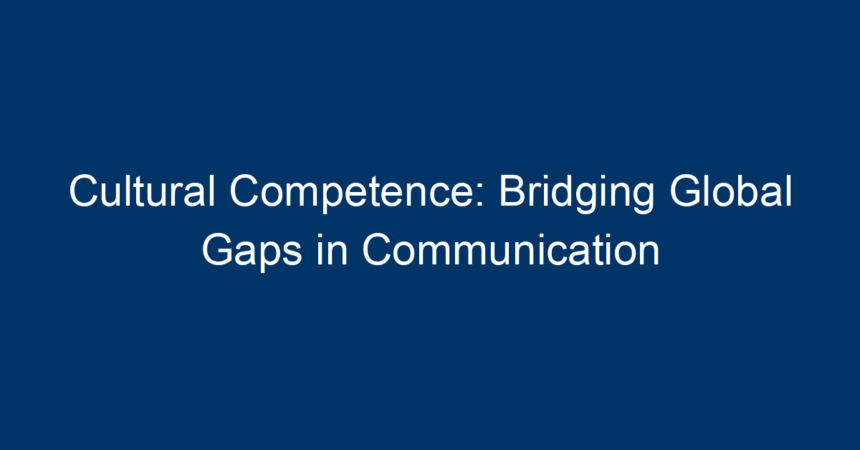In our increasingly interconnected world, the ability to communicate effectively across cultures has never been more vital. Cultural competence refers to the skills, knowledge, and attitudes that enable individuals to interact successfully with people from different cultural backgrounds. As globalization fosters diverse interactions in both personal and professional settings, enhancing cultural competence becomes essential. In this article, we will explore the significance of cultural competence, its components, and practical ways to cultivate it for better global communication.
Understanding Cultural Competence
Cultural competence is more than just awareness of different customs and traditions; it encompasses the ability to navigate cultural differences thoughtfully and respectfully. It includes three essential components:
- Knowledge: Understanding the cultural norms, values, and practices that shape a community’s identity.
- Skills: The ability to adapt communication styles and behaviors to accommodate cultural differences.
- Attitudes: Fostering an open-minded approach towards varied perspectives and embracing diversity.
Cultivating cultural competence not only enriches interactions but also enhances problem-solving and teamwork in diverse environments.
The Importance of Cultural Competence
1. Fostering Better Communication
Effective communication is foundational in any relationship, be it personal or professional. Cultural competence allows individuals to bridge communication gaps, reducing misunderstandings that often arise from cultural differences. For instance, what is considered polite in one culture may be viewed differently in another. By understanding these nuances, we can convey messages more clearly and avoid unintentional offenses.
2. Enhancing Professional Relationships
In the workplace, cultural competence is crucial for collaboration and teamwork. Diverse teams bring a wealth of perspectives that can drive innovation. However, without cultural competence, these differences can lead to conflict. Companies that prioritize cultural training report improved team dynamics, higher employee satisfaction, and better overall performance.
3. Building Inclusive Communities
Cultural competence is not just a professional necessity; it plays a significant role in social settings as well. Communities that embrace cultural diversity foster inclusion, leading to richer social tapestries. By practicing cultural competence, individuals contribute to creating environments where everyone feels valued and understood.
Key Components of Cultural Competence
Knowledge: Understanding Cultural Differences
Cultural competence starts with education. To effectively communicate, it’s vital to:
-
Learn about Different Cultures: Delve into the histories, beliefs, and values of various cultures. This understanding helps identify common ground and appreciate differences.
- Stay Informed about Current Events: Being aware of global issues affecting different cultures can enhance empathy and understanding.
Skills: Adapting Communication
Effective intercultural communication requires flexibility. Here are ways to adapt your skills:
-
Active Listening: Pay attention not only to words but also to non-verbal cues. Body language can vary across cultures, so observing these differences can help clarify meanings.
- Ask Questions: When in doubt, don’t hesitate to ask questions respectfully. This shows your commitment to understanding the other person’s perspective.
Attitudes: Embracing Diversity
Cultivating the right mindset is crucial in developing cultural competence:
-
Openness: Approach differences with curiosity rather than judgment. Embrace diversity as an opportunity for growth and learning.
- Self-awareness: Reflect on your cultural background and biases. Understanding your perspective helps you navigate interactions with greater sensitivity.
Practical Steps to Enhance Cultural Competence
1. Engage in Cultural Immersion
One of the best ways to build cultural competence is through direct exposure. Attend cultural festivals, workshops, or community events to interact with different cultures. This hands-on approach deepens your understanding and appreciation for diversity.
2. Participate in Training Programs
Many organizations offer cultural competence training. These programs provide valuable skills and insights into working within diverse environments. Employees who undergo such training are better equipped to handle intercultural interactions effectively.
3. Utilize Technology and Resources
Leverage online platforms, podcasts, books, and documentaries that focus on cultural issues. Online courses specializing in intercultural communication can also be invaluable in enhancing your skills.
4. Foster Diverse Networks
Build relationships with individuals from various cultural backgrounds. Engaging with a diverse network not only broadens your perspective but also reinforces the importance of cultural competence in a practical context.
Overcoming Challenges in Developing Cultural Competence
Developing cultural competence is not without its hurdles. Common challenges include:
1. Stereotyping and Prejudice
Negative stereotypes can cloud judgment. Becoming aware of your biases is the first step toward overcoming them. A conscious effort to see individuals beyond their cultural backgrounds can mitigate this challenge.
2. Language Barriers
Language differences can pose significant challenges in communication. It’s essential to recognize that language is intricately tied to culture. Learning a few key phrases of another language can show respect and willingness to connect.
3. Resistance to Change
Some individuals may resist embracing cultural competence due to discomfort or fear of the unknown. Overcoming this resistance requires patience and ongoing education to highlight the value of intercultural understanding.
Conclusion: Actionable Insights for Enhancing Cultural Competence
Cultural competence is an indispensable skill in today’s global society. By understanding its significance and committing to its development, individuals can build more meaningful relationships and foster a sense of belonging in diverse environments.
Actionable Steps:
- Commit to Continuous Learning: Stay curious and open to learning about different cultures.
- Practice Empathy: Put yourself in others’ shoes to understand their perspectives.
- Engage in Conversations: Initiate dialogues about cultural differences to practice and enhance your skills.
- Support Others: Advocate for cultural competence in your workplace or community, fostering an inclusive atmosphere.
As we continue to navigate an interconnected world, let us strive for cultural competence, bridging global gaps in communication and building a more inclusive society for all. Through shared understanding and respect, we can enhance not only personal relationships but also contribute to a harmonious global community.




